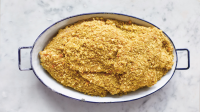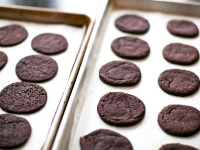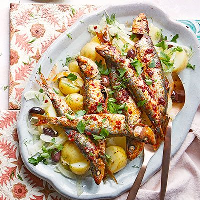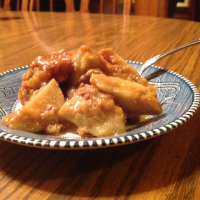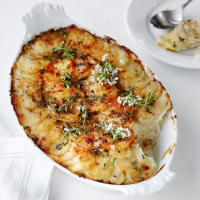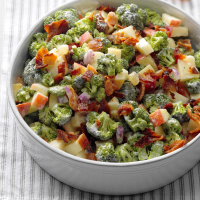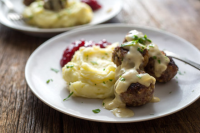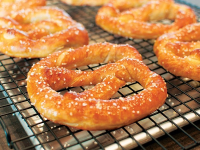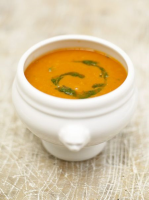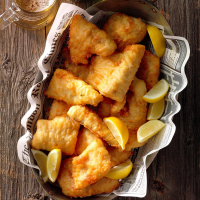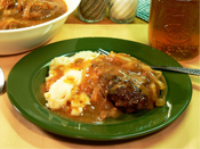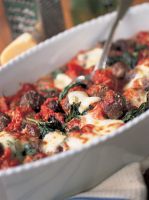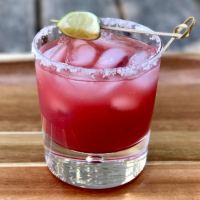PASTELóN RECIPE - NYT COOKING

Pastelón is a layered Puerto Rican casserole of plantains, cheese and picadillo, a tomato-based ground beef mixture seasoned with onions, peppers, herbs and spices. The dish is often referred to as Puerto Rican lasagna, and to say there is only one real recipe for pastelón would be like saying there’s only one true lasagna. Variations abound! Some cooks boil the plantains and make a mash with taro; others fry them until they’re sweet and crisp. Nearly any mild, meltable cheese may be used, though there is debate over whether or not to add raisins. This recipe is adapted from from Natalia Vallejo, chef and owner of Cocina al Fondo in Santurce, Puerto Rico. She doesn’t serve pastelón at her restaurant, but she grew up eating it. Her version includes fried plantains, mozzarella, fresh tomatoes and raisins, because she says “Puerto Ricans like that sweet-and-salty mix.”
Provided by Daniela Galarza
Total Time 2 hours
Yield 10 to 12 servings
Number Of Ingredients 25
Steps:
- Prepare the plantains: Line a sheet pan with paper towels; set aside. Cut off the ends of each plantain. With the tip of a knife, score plantains lengthwise and peel off the skin. Using a serrated knife or chef’s knife, cut each plantain in half lengthwise, and then halve again lengthwise so you end up with 24 long slices. (If some of the slices break or are unevenly shaped, that’s OK! Carry on.)
- In a large cast-iron or heavy skillet, heat 1 cup oil over medium-high to between 350 and 375 degrees. Working with 4 to 6 slices at a time, depending on what fits, fry plantains until deep golden brown, turning halfway through, about 6 minutes total. Transfer fried plantains to the prepared sheet pan and cook remaining plantains; set aside. (Let oil cool, then strain and reserve for another use.)
- Prepare the sofrito: Put onion, bell pepper, ají dulce chiles (if using), garlic, cilantro and culantro (if using), in a food processor; blend until it becomes a rough, wet purée. (You should have about 1 cup sofrito).
- Prepare the picadillo: In a large, heavy skillet, heat 2 tablespoons oil over medium until it shimmers. Add the sofrito and cook, stirring often, until purée thickens and starts to brown, about 5 minutes. Add the beef and stir in the salt, pepper, cumin, paprika and oregano. Cook, stirring occasionally, until beef is evenly cooked and no longer pink, about 8 minutes. Turn off heat. Push meat mixture to one side, and carefully tilt skillet so that the fat from the meat collects at the bottom of the tilted pan; spoon off and discard as much of this excess fat as you can.
- Return the skillet to medium heat. Add the chopped tomatoes, wine and tomato paste and cook, stirring occasionally, until tomatoes fall apart and the liquid starts to reduce, about 10 minutes. Turn off heat and stir in olives and raisins, if using. Season to taste with salt and pepper. (Picadillo can be made up to 2 days in advance. Rewarm it in a pan on the stove before proceeding with recipe.)
- Prepare the pastelón: Heat the oven to 350 degrees. Grease a 9-by-13-inch glass baking dish with butter. Whisk the eggs with a pinch of salt and set aside.
- Lay half the fried plantain slices along the bottom of the baking dish crosswise, piecing any broken pieces together to form an even layer. (If there are small gaps in the plantain layer, this is OK.) Top with half the picadillo (about 2 cups), smoothing it into an even layer, then sprinkle half the cheese on top in an even layer. Repeat with another layer of plantains then the remaining picadillo. Pour the whisked eggs evenly over the picadillo layer and spread it so it settles down into the pastelón. Sprinkle the remaining cheese on top.
- Bake the pastelón until the egg is cooked, the cheese is melted and the layers are set, 20 to 30 minutes. Cut into squares and serve hot.
VEGETARIAN SHEPHERD’S PIE RECIPE - NYT COOKING
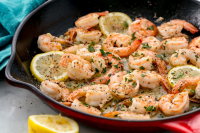
French green lentils (Puy lentils) make a hearty base for this vegetarian shepherd’s pie. They may be slighter harder to find than other lentils, but they’re worth the extra effort. Unlike brown or red lentils, green lentils retain their shape and texture after cooking, which means they stand up well to a long simmer and this rich potato topping. Store-bought vegetable stock can vary greatly so be sure to buy one with a pleasant flavor that isn’t too sweet. (Note: Parmigiano-Reggiano cheese contains rennet, so it is not vegetarian. Use a vegetarian Parmesan or leave it out. If you leave it out, be sure to season the potatoes well with salt and pepper.)
Provided by Samantha Seneviratne
Total Time 1 hours 45 minutes
Yield 4 to 6 servings
Number Of Ingredients 21
Steps:
- In a large pot, bring a gallon of water and 2 tablespoons salt to a boil over high heat. Add potatoes to boiling water and boil for about 15 to 20 minutes, until soft; a knife should go in with almost no resistance.
- Meanwhile, prepare the filling: In a 10-inch oven-safe skillet with high sides or an enameled cast-iron braiser over medium-high heat, bring the lentils, thyme and 2 cups of the broth to a simmer with 1 teaspoon salt. Reduce the heat and continue to cook the lentils, partly covered, until they are tender and most of the liquid is absorbed, about 20 minutes. Transfer the lentils to a bowl.
- Finish the topping: In a small saucepan or a microwave oven, heat 6 tablespoons of the butter and milk together until butter melts. Drain potatoes well and return to pot. Using a masher or a ricer, mash hot potatoes until smooth. Mix in the hot butter mixture and sour cream just until blended. Stir in 1/2 of the Parmigiano. Season to taste with salt and pepper. Cover and set aside.
- Finish the filling: Heat the oven to 375 degrees. Melt the butter in the 10-inch skillet over medium-high heat. Add the mushrooms and cook, stirring often with a wooden spoon, until they are deep golden brown, about 8 to 10 minutes. Reduce the heat to medium and add leeks, carrots and garlic, and continue to cook until tender, another 10 minutes. Season to taste with salt and pepper. Add the tomato paste and stir, cooking until it is well combined, another 2 to 3 minutes. Sprinkle flour over the mixture, stir and cook for 1 minute. Add remaining 1 1/2 cups broth, cooked lentils and peas, and cook until thickened. Remove thyme stems and stir in lemon juice to taste.
- Top the mixture with dollops of the mashed potatoes, then spread them out over the top. (Or transfer the lentil mixture to a 3-quart casserole dish and spread into an even layer, and top with potatoes.) Sprinkle with the remaining Parmigiano. Transfer to the oven and, if the mixture is at the top edges of your pan, set a foil-lined baking sheet underneath the pan to catch any drips. Bake the pie until the potatoes have begun to brown and the edges are bubbling, about 30 minutes. Let stand at room temperature for 15 minutes before serving.
Nutrition Facts : @context http//schema.org, Calories 490, UnsaturatedFatContent 8 grams, CarbohydrateContent 58 grams, FatContent 24 grams, FiberContent 8 grams, ProteinContent 14 grams, SaturatedFatContent 15 grams, SodiumContent 1149 milligrams, SugarContent 7 grams, TransFatContent 1 gram
More about "lasagna recipe nytimes recipes"
FALAFEL RECIPE - NYT COOKING
You shouldn’t reject deep-frying at home; I do it about once a month. It can be fast and easy, and you can deep-fry plants. (And anything else.)
Frying is thought of as messy, but this can be mitigated by the simplest of measures: using a pot that is heavy, broad and deep, like a well-made stockpot. Choose this, add a fair amount of oil, and the process is simplified and neat.
Add your food in batches and don’t crowd; you do not want the temperature to plummet, nor do you want the pieces of food nestling against one another. (Though it’s fine if they bump.) You may or may not have to turn the pieces, but that’s easy, because they’ll be floating and they won’t stick. Remove them with a slotted spoon, tongs or spider; you’ll know when they’re done because the color will be evenly gorgeous.
From cooking.nytimes.com
Reviews 5
Total Time 1 hours
Calories 243 per serving
From cooking.nytimes.com
Reviews 5
Total Time 1 hours
Calories 243 per serving
- Scoop out heaping tablespoons of the mixture and shape it into balls or small patties. Fry in batches, without crowding, until nicely browned, turning as necessary; total cooking time per batch will be less than 5 minutes. Serve hot or at room temperature.
See details
CORNBREAD TAMALE PIE RECIPE - NYT COOKING
This recipe came to The Times in a 2006 magazine article about the 75th anniversary edition of The Joy of Cooking, the soup-to-nuts cookbook found on practically every home cook's shelf since its first publication in 1931. Like many of the book's beloved recipes, this dish is a crowd-pleasing, homespun classic that is incredibly simple to put together. First, make a quick chili of beef, black beans, corn, green pepper and onion seasoned with chile power and cumin. Spread that in a baking dish, top with a simple cornbread batter and pop it into the oven. In about a half hour: tamale pie. Serve with hot sauce, a dollop of sour cream and a few slices of avocado. If you're trying to eat less red meat, ground turkey or chicken would make a fine substitute for the beef.
From cooking.nytimes.com
Reviews 4
Total Time 1 hours
Calories 445 per serving
From cooking.nytimes.com
Reviews 4
Total Time 1 hours
Calories 445 per serving
- In a medium bowl, whisk together the cornmeal, flour, sugar, baking powder and teaspoon salt. In a small bowl whisk together the egg, milk and oil until combined. Whisk the milk mixture into the flour mixture until combined. Spread the meat mixture into the casserole dish and cover with the corn bread topping. The topping will disappear into the meat mixture but will rise during baking and form a layer of corn bread. Bake until the corn bread is brown, 20 to 25 minutes.
See details
LASAGNA RECIPE - NYT COOKING
In 2001, Regina Schrambling went on a week long odyssey in search of the ultimate lasagna recipe. She tested several, and finally found her ideal in a mash-up of recipes from Giuliano Bugialli and Elodia Rigante, both Italian cookbook authors.
“If there were central casting for casseroles, this one deserved the leading role. But its beauty was more than cheese deep. This was the best lasagna I had ever eaten. The sauce was intensely flavored, the cheeses melted into creaminess as if they were bechamel, the meat was just chunky enough, and the noodles put up no resistance to the fork. Most important, the balance of pasta and sauce was positively Italian. At last I could understand why my neighbor Geoff had told me, as I dragged home more bags in our elevator, that all-day lasagna is the only kind worth making.”
From cooking.nytimes.com
Reviews 5
Total Time 4 hours
Cuisine italian
Calories 1085 per serving
From cooking.nytimes.com
Reviews 5
Total Time 4 hours
Cuisine italian
Calories 1085 per serving
- Remove the meatballs and sausage from the sauce, and set aside to cool slightly, then chop coarsely. Spoon a thick layer of sauce into the bottom of a 9-by-12-inch lasagna pan. Cover with a layer of noodles. Spoon more sauce on top, then add a third of the meat and a third of the cheese mixture. Repeat for 2 more layers, using all the meat and cheese. Top with a layer of noodles, and cover with the remaining sauce. Sprinkle reserved mozzarella evenly over the top. Bake 30 minutes. Let stand 10 minutes before serving.
See details
PASTELóN RECIPE - NYT COOKING
Pastelón is a layered Puerto Rican casserole of plantains, cheese and picadillo, a tomato-based ground beef mixture seasoned with onions, peppers, herbs and spices. The dish is often referred to as Puerto Rican lasagna, and to say there is only one real recipe for pastelón would be like saying there’s only one true lasagna. Variations abound! Some cooks boil the plantains and make a mash with taro; others fry them until they’re sweet and crisp. Nearly any mild, meltable cheese may be used, though there is debate over whether or not to add raisins. This recipe is adapted from from Natalia Vallejo, chef and owner of Cocina al Fondo in Santurce, Puerto Rico. She doesn’t serve pastelón at her restaurant, but she grew up eating it. Her version includes fried plantains, mozzarella, fresh tomatoes and raisins, because she says “Puerto Ricans like that sweet-and-salty mix.”
From cooking.nytimes.com
Reviews 4
Total Time 2 hours
Cuisine american
From cooking.nytimes.com
Reviews 4
Total Time 2 hours
Cuisine american
- Bake the pastelón until the egg is cooked, the cheese is melted and the layers are set, 20 to 30 minutes. Cut into squares and serve hot.
See details















